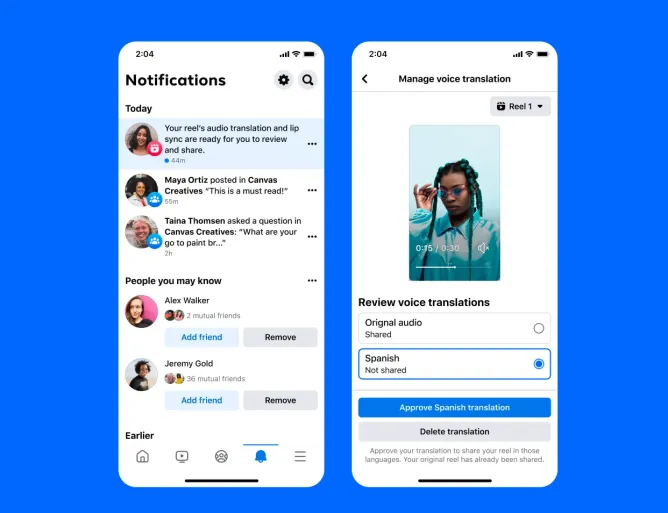Meta is making a big move to break down language barriers on social media. The company has officially launched its AI-powered voice translation tool for Facebook and Instagram creators, bringing new ways to connect with audiences across cultures and geographies.
The rollout, announced this week, marks one of Meta’s most ambitious steps yet in blending artificial intelligence with content creation. The feature is now available globally in regions where Meta AI is supported. At its core, the tool allows creators to instantly translate their content into another language — while keeping their own voice and vocal style intact.
A Leap Beyond Subtitles
For years, creators and influencers have relied on subtitles or third-party dubbing to reach new audiences. But Meta’s latest AI innovation goes a step further. Instead of a generic synthetic voice, the translations preserve the creator’s natural voice, complete with tone and inflection.
This makes the dubbed version feel more personal and authentic. Viewers don’t just hear the translation they hear it as though the creator themselves is speaking directly in their language.
Meta has also introduced an optional lip-sync feature, which aligns the translated audio with the speaker’s mouth movements. This extra touch makes the video feel smoother and more natural, cutting down on the awkwardness often associated with dubbed content.
At launch, translations are supported between English and Spanish — two of the most widely spoken languages on social media. The company says more languages will be added in the future, though it has not yet shared a roadmap.

How Creators Can Use It
The process is simple and fully integrated into the posting flow. When uploading a reel, creators will see the option to “Translate your voice with Meta AI.” From there, they can:
- Turn translations on or off
- Enable or disable lip-sync
- Preview the translation before posting
Once published, the translated version is immediately available to viewers. Reels that use AI translation carry a small label at the bottom of the screen, letting audiences know that Meta AI was used. For those who prefer to see only original content, the option to disable translated reels is available in settings.
Insights That Go Beyond Numbers
Meta is pairing this tool with deeper analytics for creators. Inside the Insights dashboard, creators can now view their audience breakdown by language. This new metric shows how much of their engagement is coming from translated content, offering a clearer picture of how global their reach really is.
As the feature expands to more languages, these insights could become invaluable for creators who are looking to scale their brand across borders.
Tips for Best Performance
Like any AI tool, the quality of the results depends on the input. Meta has shared a few best practices for creators who want the most natural translations:
- Speak clearly while facing forward
- Avoid covering your mouth
- Keep background noise or music to a minimum
- Limit reels to two speakers (without overlapping dialogue)
These guidelines help the AI capture voice patterns more accurately and generate smoother lip-sync translations.
Extra Options for Facebook Creators
On Facebook, creators have an additional advantage. Through the Meta Business Suite, they can upload up to 20 dubbed audio tracks in different languages to a reel. Unlike the AI feature, these tracks can be added before or after publishing. This manual option gives creators more flexibility to tailor content for multilingual audiences, especially in cases where precise cultural nuances matter.

Why This Matters for Creators
For content creators, language has long been one of the biggest barriers to growth. Even if a video goes viral in one region, it may fail to gain traction in another simply because of language differences. By automating translations while keeping the creator’s own voice, Meta is effectively giving creators a passport to reach entirely new communities.
Instagram head Adam Mosseri summarized this vision in a post:
“We believe there are lots of amazing creators out there who have potential audiences who don’t necessarily speak the same language. If we can help you reach across cultural and linguistic barriers, we can help you grow your following and get more value out of Instagram and the platform.”
A Strategic Move in AI
The timing of this launch also highlights Meta’s broader strategy in artificial intelligence. Reports suggest the company is restructuring its AI division to focus on four core areas:
- Research
- Superintelligence
- Products
- Infrastructure
Voice translation fits neatly into the product category, showcasing how Meta is turning cutting-edge AI into user-friendly tools that directly impact creator growth.
It’s also a competitive play. TikTok, YouTube, and other platforms are experimenting with translation and dubbing features, but Meta’s decision to use AI voice cloning and lip-syncing could give it an edge in creator adoption.
The Road Ahead
While English and Spanish are just the starting point, the potential for this technology is massive. Imagine a Japanese creator instantly connecting with audiences in Brazil, or a Brazilian chef reaching food lovers in France all without needing to learn another language.
As more languages roll out, this could fundamentally reshape how creators think about content distribution. For audiences, it could mean that cultural and linguistic walls become less relevant, and global content feels more accessible than ever before With AI-driven voice translations, Meta isn’t just rolling out another feature — it’s signaling a future where content knows no borders. If executed well, this could be one of the most impactful creator tools the company has ever released.
sources ( Techcrunch )




